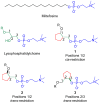Discovery of Cyclopentane-Based Phospholipids as Miltefosine Analogs with Superior Potency and Enhanced Selectivity Against Naegleria fowleri
- PMID: 40732274
- PMCID: PMC12298883
- DOI: 10.3390/ph18070984
Discovery of Cyclopentane-Based Phospholipids as Miltefosine Analogs with Superior Potency and Enhanced Selectivity Against Naegleria fowleri
Abstract
Background/Objectives:Naegleria fowleri is a free-living amoeba that invades brain tissues causing fatal primary amoebic meningoencephalitis (PAM). An effective and tolerable therapeutic agent is still lacking. Methods: A series of conformationally restricted analogs of miltefosine with varied restriction positions, stereochemical configuration and lengths of alkyl chain was investigated to discover more effective and less toxic agents than miltefosine. Results: Among tested compounds, derivatives 2a, 3b and 3d featuring 1,2- or 2,3-positional restriction with trans-configuration and tridecyl or behenyl alkyl chains were discovered as more potent and less cytotoxic agents. Compounds 2a, 3b and 3d elicited 3.49-, 3.58- and 6.03-fold relative potencies to miltefosine and 7.53, 3.90 and 3.49 selectivity indices, respectively. Furthermore, compounds 2a and 3b showed IC90 values for N. fowleri lower than CC50 against glial C6 cells. Compounds 2a, 3b and 3d induced morphological changes and programmed cell death of N. fowleri via the apoptosis-like pathway. The induced death of N. fowleri involved DNA fragmentation along with the loss of mitochondrial membrane potential. Conclusions: The current research presents compounds 2a and 3b as more potent, selective and effective agents than miltefosine against N. fowleri for further development.
Keywords: Naegleria fowleri; miltefosine analogs; potential drug; primary amoebic meningoencephalitis.
Conflict of interest statement
The authors declare no conflicts of interest.
Figures







Similar articles
-
Computational discovery of potential therapeutic agents against brain-eating amoeba (Naegleria fowleri).PLoS One. 2025 Jul 11;20(7):e0327621. doi: 10.1371/journal.pone.0327621. eCollection 2025. PLoS One. 2025. PMID: 40644400 Free PMC article.
-
Systematic Review of Brain-Eating Amoeba: A Decade Update.Int J Environ Res Public Health. 2023 Feb 9;20(4):3021. doi: 10.3390/ijerph20043021. Int J Environ Res Public Health. 2023. PMID: 36833715 Free PMC article.
-
Secreted small RNAs of Naegleria fowleri are biomarkers for diagnosis of primary amoebic meningoencephalitis.bioRxiv [Preprint]. 2025 May 14:2025.01.11.632551. doi: 10.1101/2025.01.11.632551. bioRxiv. 2025. PMID: 39868105 Free PMC article. Preprint.
-
Rare Naegleria fowleri meningoencephalitis diagnosed via combined molecular biology and metagenomic sequencing techniques: a case report.Infect Dis Poverty. 2025 Jul 17;14(1):69. doi: 10.1186/s40249-025-01347-z. Infect Dis Poverty. 2025. PMID: 40676680 Free PMC article.
-
Adefovir dipivoxil and pegylated interferon alfa-2a for the treatment of chronic hepatitis B: a systematic review and economic evaluation.Health Technol Assess. 2006 Aug;10(28):iii-iv, xi-xiv, 1-183. doi: 10.3310/hta10280. Health Technol Assess. 2006. PMID: 16904047
References
Grants and funding
LinkOut - more resources
Full Text Sources
Medical
Miscellaneous

